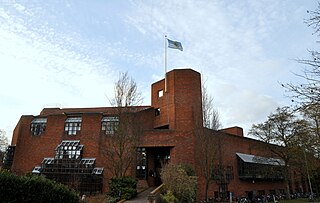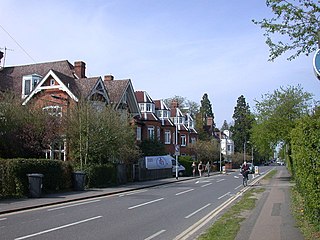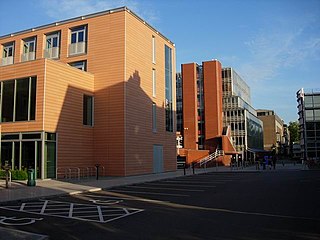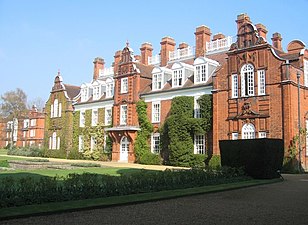
Selwyn College, Cambridge is a constituent college of the University of Cambridge. The college was founded in 1882 by the Selwyn Memorial Committee in memory of George Augustus Selwyn (1809–1878), the first Bishop of New Zealand (1841–1868), and subsequently Bishop of Lichfield (1868–1878). Its main buildings consist of three courts built of stone and brick. There are several secondary buildings, including adjacent townhouses and lodges serving as student hostels on Grange Road, West Road and Sidgwick Avenue. The college has some 60 fellows and 110 non-academic staff.

Henry Sidgwick was a British utilitarian philosopher and economist and is best known in philosophy for his utilitarian treatise The Methods of Ethics. His work in economics has also had a lasting influence. He was the Knightbridge Professor of Moral Philosophy at the University of Cambridge from 1883 until his death. He was one of the founders and first president of the Society for Psychical Research and a member of the Metaphysical Society and promoted the higher education of women. In 1875, with Millicent Garrett Fawcett, he co-founded Newnham College, a women-only constituent college of the University of Cambridge. It was the second Cambridge college to admit women, after Girton College. In 1856, Sidgwick joined the Cambridge Apostles intellectual secret society.

Robinson College is a constituent college of the University of Cambridge. Founded in 1977, it is one of the newest Oxbridge colleges and is unique in having been intended, from its inception, for both undergraduate and graduate students of both sexes.

Newnham College is a women's constituent college of the University of Cambridge.

Ridley Hall is a theological college located on the corner of Sidgwick Avenue and Ridley Hall Road in Cambridge, which trains men and women intending to take Holy Orders as deacon or priest of the Church of England, and members of the laity working with children and young people as lay pioneers and within a pastoral capacity such as lay chaplaincy.

Anne Jemima Clough was an early English suffragist and a promoter of higher education for women. She was the first principal of Newnham College.

The Sidgwick Site is one of the largest sites within the University of Cambridge, England.

Mary Marshall was a British economist who in 1874 was one of the first women to take the Tripos examination at Cambridge University – although, as a woman, she was excluded from receiving a degree. She was one of a group of five women who were the first to be admitted to study at Newnham College, the second women's college to be founded at the University.

Eleanor Mildred Sidgwick was a physics researcher assisting Lord Rayleigh, an activist for the higher education of women, Principal of Newnham College of the University of Cambridge, and a leading figure in the Society for Psychical Research.

The Marshall Library of Economics is a library of the University of Cambridge, England.

Grange Road is a street in Cambridge, England. It stretches north–south, meeting Madingley Road (A1303) at a T-junction to the north and Barton Road (A603) to the south. It runs approximately parallel with the River Cam to the east. Grange Road is almost one mile long and has 17th-century origins. It contains several colleges of the University of Cambridge.

West Road is located in western Cambridge, England. It links Grange Road to the west with Queen's Road to the east. The road is north of Sidgwick Avenue and the Sidgwick Site, a major site of the University of Cambridge, currently under redevelopment. Facilities on West Road include the Cambridge University Faculty of Law, the Faculty of Music, the Faculty of English and the Department of Anglo-Saxon, Norse and Celtic, and the West Road Concert Hall.

Silver Street is located in the southwest of central Cambridge, England. It links Queen's Road to the west with Trumpington Street to the east. The road continues west out of central Cambridge as Sidgwick Avenue.

Queen's Road is a major road to the west of central Cambridge, England. It links with Madingley Road and Northampton Street to the north and with Sidgwick Avenue, Newnham Road and Silver Street to the south.

Regent Street is an arterial street in southeast central Cambridge, England. It runs between St Andrew's Street, at the junction with Park Terrace, to the northwest and Hills Road at the junction with the A603 to the southeast. Regent Terrace runs in parallel immediately to the northeast. Beyond that is Parker's Piece, a large grassed area with footpaths.
The Casimir Lewy Library is the library of the Faculty of Philosophy at the University of Cambridge. The library is located in the Raised Faculty building on the Sidgwick Site, Sidgwick Avenue, Cambridge. It is open to all members of the university.

Edith Sharpley (1859–1940) was a Classical Lecturer at Newnham College, Cambridge from 1884 to 1910.

The Ladies Dining Society was a private women's dining and discussion club, based at Cambridge University. It was founded in 1890 by the author Louise Creighton and the women's activist Kathleen Lyttelton. Its members, most of whom were married to Cambridge academics, were believers in women’s education and were active in the campaign to grant women Cambridge degrees. Most were strong supporters of female suffrage.

There are 833 listed buildings in the district of Cambridge, England. This list summarises the 87 in the west and north-west suburbs, in the area west of the Backs and broadly between Huntingdon Road, Queen's Road, Barton Road and the M11. This was the West Fields, which largely passed into the ownership of the Cambridge colleges, particularly St John's, after enclosure in 1805, and was little developed until after 1870; the older population centres of Castle Hill and Newnham are excluded from this list. The major roads are Madingley Road running east–west and Grange Road running north–south. There are 18 buildings listed at grade II*, with the remainder at grade II; there are no grade-I-listed buildings in this area.






















